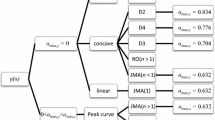Abstract
A method for determining the activation energy for crystal growth was calculated on the basis of the heat balance in the differential thermal analysis (DTA) measurements and the mechanism of nucleation and growth. The theoretical analysis showed that the term ln[C pd(δT)/dt+KδT] should be a linear function of l/T, whereC p is the heat capacity of sample and sample holder,K is the heat transfer coefficient,δT is the temperature difference between the sample and reference substance andt is the time. The energy term,E D, obtained by multiplying the slope of the resulting straight line byR is indicative of the activation energy for crystal growth. It was shown thatE D should be three times the activation energy for crystal growth when bulk nucleation is dominant, and equal to that for crystal growth only when surface nucleation predominates. The result of the analysis was tested by comparing the experimentally determinedE D's with the activation energy for viscous flow, which was known to represent that for crystal growth. TheE D for Li2O·2SiO2 glass with dominant bulk nucleation, approached three times the activation energy for viscous flow, as the heating rate in DTA decreased. TheE D for 33.3Li2O·66.7SiO2·3TiO2 glass with dominant surface nucleation approached the activation energy for viscous flow as the heating rate increased, suggesting the validity of the analysis.
Similar content being viewed by others
References
H. J. Borchardt andF. Daniels,J. Amer. Chem. Soc. 79 (1957) 41.
H. E. Kissinger,J. Res. Nat. Bur. Stand. 57 (1956) 217.
Idem, Anal. Chem. 29 (1957) 1702.
G. O. Piloyan, I. D. Ryabchikov andO. S. Nevikova,Nature 212 (1966) 1229.
R. L. Thakur andS. Thiagarajan,Glass Ceram. Bull. 13 (1966) 33.
S. Risbud,J. Amer. Ceram. Soc. 56 (1973) 440.
D. Clinton, R. A. Mercer andR. P. Miller,J. Mater. Sci. 5 (1970) 171.
D. Turnbull andM. H. Cohen, “Modern Aspects of the Vitreous State”, edited by J. D. Mackenzie, Vol. 1 (Butterworth, London, 1960) pp. 38–62.
K. Matusita andM. Tashiro,J. Non-Cryst. Solids 11 (1973) 471.
M. Tomazawa,Phys. Chem. Glasses 13 (1972) 161.
M. Ito, T. Sakaino andT. Moriya,Bull. Tokyo Inst. Technol. 88 (1968) 127.
K. Nakagawa andT. Izumitani,Phys. Chem. Glasses 10 (1969) 179.
K. Matusita andM. Tashiro,Phys. Chem. Glasses 14 (1973) 77.
Idem, Yogyo-Kyokai-Shi (J. Ceram. Soc. Japan)81 (1973) 500.
K. Matusita, T. Maki andM. Tashiro,Phys. Chem. Glasses 15 (1974), in press.
M. E. Fine, “Introduction to Phase Transformation in Condensed System” (Macmillan, New York, 1964).
K. Matusita, S. Sakka, T. Maki andM. Tashiro,J. Mater. Sci. 10 (1975) 94.
K. Takahashi andT. Yoshio, private communication.
O. Kubaschewski andE. L. Evans, “Metallurgical Thermochemistry” (Pergamon Press, 1958) p. 310.
Author information
Authors and Affiliations
Rights and permissions
About this article
Cite this article
Matusita, K., Sakka, S. & Matsui, Y. Determination of the activation energy for crystal growth by differential thermal analysis. J Mater Sci 10, 961–966 (1975). https://doi.org/10.1007/BF00823212
Received:
Accepted:
Issue Date:
DOI: https://doi.org/10.1007/BF00823212




